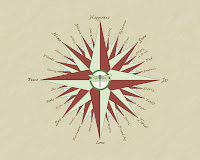My son is in second grade, and his teacher was absent for a couple of days this week so I volunteered to teach the geography lesson. I spent about 45 minutes
teaching the kids about geographic projections. It was so much fun! The
kids were all enthusiastic, attentive, observant, and lots of fun.
We started with a discussion about the shape of the Earth, using a
globe as an example, and talked about why it's usually more convenient
to have a flat map on paper or on a screen when you need to do something
map related. Then we talked about how the transition is made from three
dimensions to two, and I passed out a satsuma to every student. I asked
them to pretend their orange was the Earth and asked them to transform
the orange peel into a flat, rectangular surface. Before they began, I
explained that there is no wrong or right solution, and that the task is
in fact
impossible--but it would be really interesting and fun to try to solve
it. They worked cooperatively to complete their 'projections.' After all
the kids were finished, they ate the oranges, then took turns table by
table looking at the solutions generated by their classmates. I asked
them to make observations: what did the solutions have in common? how
were they different? what conclusions could they draw? Then we gathered
on the floor and they shared their observations.
This
is the part that really blew me away--of course, they all quickly
ascertained that it was a very tricky problem, but they also understood
that for small areas, it was possible to minimize the distortion of the
peel, and that certain patterns seemed easier to work with than others.
Many of the kids kept their peels in one piece, some intentionally split
them into numerous pieces and re-assembled it, and some did a bit of
both. During the discussion,
every student made an observation or asked a question, and many did
both.
After the discussion I drew a picture
illustrating the mechanics of translating the a sphere to a flat
surface, then showed them a poster I prepared showing nine different
global projections, ranging from Mercator to Sinusoidal to
Goode-Homolosine. We didn't spend a ton of time on any particular
projection, but we did discuss the various applications for some of them
(i.e., Mercator is great for navigation but not so good for wall maps)
and they all saw that the projections are just as varied as their
orange-peel solutions.
At the very end I passed
out a make-your-own-globe paper that I found here. I
demonstrated to the class how to make the globe, using these directions:
1. Cut around the 12
segments (gores) that make up the globe. Cut right in between the gores
so your scissors almost touch the equator (the line running through the
middle) but don't cut all the way through!
2. Roll the cut-out into a cylinder and tape together both ends of the equator where they meet.
3.
Take four pieces of tape, cross two, cross the other two, then cross
the two sets (so you've created an asterisk of tape) and place it on the
pointed end of one of the gores, so the sticky side faces upwards.
4. Bend the other 11 gores into the middle, so the tips meet at the same point.
5. Stick them down firmly on the tape. This end should now be cupped.
6. Do the same with the gores at the other end to create a sphere.
Don't
be disappointed if your globe is not a perfect sphere. It is actually
impossible to recreate a perfect sphere from a simple template like
this!
In fact, at the beginning of the lesson, I told the kids we were going
to attempt two impossible things. The orange peel projection was the
first, and creating a 3D sphere from a 2D sheet of paper is the second!
Have fun making your globes. :)







